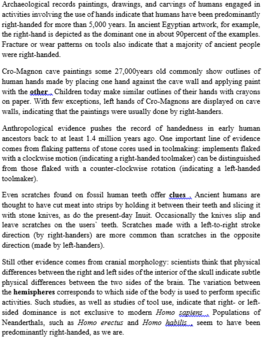Read the following passage and mark the letter A, B, C, or D on your answer sheet to indicate the correct answer to each of the questions from 28 to 34.
The main difference between urban growth in Europe and in the American colonies was the slow evolution of cities in the former and their rapid growth in the latter. In Europe they grew over a period of centuries from town economies to their present urban structure. In North America, they started as wilderness communities and developed to mature urbanism’s in little more than a century.
In the early colonial day in North America, small cities sprang up along the Atlantic Coastline, mostly in what are now New America, small cities sprang up along the Atlantic United States and in the lower Saint Lawrence valley in Canada. This was natural because these areas were nearest England and France, particularly England, from which most capital goods (assets such as equipment) and many consumer goods were imported Merchandising establishments were, accordingly, advantageously located in port cities from which goods could be readily distributed to interior settlements. Here, too, were the favored locations for processing raw materials prior to export. Boston, Philadelphia, New York, Montreal, and other cities flourished, and, as the colonies grew, these cities increased in importance.
This was less true in the colonial South, where life centered around large farms, known as plantations, rather than around towns, as was the case in the areas further north along the Atlantic coastline. The local isolation and the economic self-sufficiency of the plantations were antagonistic to the development of the towns. The plantations maintained their independence because they were located on navigable streams and each had a wharf accessible to the small shipping of that day. In fact, one of the strongest factors in the selection of plantation land was the desire to have it front on a water highway.
When the United States became an independent nation in 1776, it did not have a single city as large as 50,000 inhabitants, but by 1820 it had a city of more than 10,000 people, and by 1880 it had recorded a city of over one million. It was not until after 1823, after the mechanization of the spinning and weaving industries, that cities started drawing young people away from farms. Such migration was particularly rapid following the Civil War (1861-1865).
According to the passage, early colonial cities were established along the Atlantic coastline of North America due to
A. an abundance of natural resources
B. financial support from colonial governments
C. proximity to parts of Europe
D. a favorable climate






Chọn đáp án C
Theo bài đọc, những thành phố thuộc địa ban đầu được thành lập dọc theo bờ biển Đại Tây Dương của Bắc Mỹ vì _________.
A. sự phong phú về tải nguyên thiên nhiên
B. hỗ trợ tài chính từ chính quyền thuộc địa
C. gần với các vùng của châu Âu
D. khí hậu thuận lợi
Dẫn chứng: In the early colonial day in North America, small cities sprang up along the Atlantic Coastline... This was natural because these areas were nearest England and France, particularly England...” (Vào đầu thời kỳ thuộc địa ở Bắc Mỹ, các thành phố nhỏ mọc lên dọc theo bờ biển Đại Tây Dương... Điều này là tự nhiên bởi vì những khu vực này gần Anh và Pháp, đặc biệt là nước Anh...